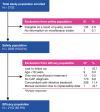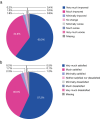Efficacy and safety of moxifloxacin in community acquired pneumonia: a prospective, multicenter, observational study (CAPRIVI)
- PMID: 24975809
- PMCID: PMC4105837
- DOI: 10.1186/1471-2466-14-105
Efficacy and safety of moxifloxacin in community acquired pneumonia: a prospective, multicenter, observational study (CAPRIVI)
Abstract
Background: Community acquired pneumonia (CAP) is a major cause of morbidity, hospitalization, and mortality worldwide. Management of CAP for many patients requires rapid initiation of empirical antibiotic treatment, based on the spectrum of activity of available antimicrobial agents and evidence on local antibiotic resistance. Few data exist on the severity profile and treatment of hospitalized CAP patients in Eastern and Central Europe and the Middle East, in particular on use of moxifloxacin (Avelox®), which is approved in these regions.
Methods: CAPRIVI (Community Acquired Pneumonia: tReatment wIth AVelox® in hospItalized patients) was a prospective observational study in 12 countries: Croatia, France, Hungary, Kazakhstan, Jordan, Kyrgyzstan, Lebanon, Republic of Moldova, Romania, Russia, Ukraine, and Macedonia. Patients aged >18 years were treated with moxifloxacin 400 mg daily following hospitalization with a CAP diagnosis. In addition to efficacy and safety outcomes, data were collected on patient history and disease severity measured by CRB-65 score.
Results: 2733 patients were enrolled. A low severity index (i.e., CRB-65 score <2) was reported in 87.5% of CAP patients assessed (n=1847), an unexpectedly high proportion for hospitalized patients. Moxifloxacin administered for a mean of 10.0 days (range: 2.0 to 39.0 days) was highly effective: 96.7% of patients in the efficacy population (n=2152) improved and 93.2% were cured of infection during the study. Severity of infection changed from "moderate" or "severe" in 91.8% of patients at baseline to "no infection" or "mild" in 95.5% at last visit. In the safety population (n=2595), 127 (4.9%) patients had treatment-emergent adverse events (TEAEs) and 40 (1.54%) patients had serious TEAEs; none of these 40 patients died. The safety results were consistent with the known profile of moxifloxacin.
Conclusions: The efficacy and safety profiles of moxifloxacin at the recommended dose of 400 mg daily are characterized in this large observational study of hospitalized CAP patients from Eastern and Central Europe and the Middle East. The high response rate in this study, which included patients with a range of disease severities, suggests that treatment with broader-spectrum drugs such as moxifloxacin is appropriate for patients with CAP who are managed in hospital.
Trial registration: ClinicalTrials.gov identifier: NCT00987792.
Figures




Similar articles
-
Efficacy and safety of moxifloxacin in acute exacerbations of chronic bronchitis: a prospective, multicenter, observational study (AVANTI).BMC Pulm Med. 2013 Jan 23;13:5. doi: 10.1186/1471-2466-13-5. BMC Pulm Med. 2013. PMID: 23343427 Free PMC article. Clinical Trial.
-
Efficacy and safety of oral solithromycin versus oral moxifloxacin for treatment of community-acquired bacterial pneumonia: a global, double-blind, multicentre, randomised, active-controlled, non-inferiority trial (SOLITAIRE-ORAL).Lancet Infect Dis. 2016 Apr;16(4):421-30. doi: 10.1016/S1473-3099(16)00017-7. Epub 2016 Feb 5. Lancet Infect Dis. 2016. PMID: 26852726 Clinical Trial.
-
Efficacy and safety of ten day moxifloxacin 400 mg once daily in the treatment of patients with community-acquired pneumonia. Community Acquired Pneumonia Study Group.Respir Med. 2000 Feb;94(2):97-105. doi: 10.1053/rmed.1999.0710. Respir Med. 2000. PMID: 10714413 Clinical Trial.
-
Delafloxacin: A Review in Community-Acquired Pneumonia.Drugs. 2022 Jun;82(8):913-923. doi: 10.1007/s40265-022-01725-z. Epub 2022 Jun 16. Drugs. 2022. PMID: 35708893 Review.
-
Community-acquired pneumonia and tuberculosis: differential diagnosis and the use of fluoroquinolones.Int J Infect Dis. 2014 Jan;18:14-21. doi: 10.1016/j.ijid.2013.09.013. Epub 2013 Oct 26. Int J Infect Dis. 2014. PMID: 24211230 Review.
Cited by
-
Influence of Moxifloxacin on Hepatic Redox Status and Plasma Biomarkers of Hepatotoxicity and Nephrotoxicity in Rat.Biochem Res Int. 2015;2015:192724. doi: 10.1155/2015/192724. Epub 2015 Oct 13. Biochem Res Int. 2015. PMID: 26550491 Free PMC article.
-
Association Between Initial Route of Fluoroquinolone Administration and Outcomes in Patients Hospitalized for Community-acquired Pneumonia.Clin Infect Dis. 2016 Jul 1;63(1):1-9. doi: 10.1093/cid/ciw209. Epub 2016 Apr 5. Clin Infect Dis. 2016. PMID: 27048748 Free PMC article.
-
Antibiotic Consumption During a 4-year Period in a Community Hospital with an Antimicrobial Stewardship Program.Oman Med J. 2016 Sep;31(5):352-6. doi: 10.5001/omj.2016.70. Oman Med J. 2016. PMID: 27602189 Free PMC article.
-
Moxifloxacin monotherapy versus combination therapy in patients with severe community-acquired pneumonia evoked ARDS.BMC Anesthesiol. 2017 Jun 14;17(1):78. doi: 10.1186/s12871-017-0376-5. BMC Anesthesiol. 2017. PMID: 28615012 Free PMC article.
References
-
- Wiemken TL, Peyrani P, Ramirez JA. Global changes in the epidemiology of community-acquired pneumonia. Semin Respir Crit Care Med. 2012;33(3):213–219. - PubMed
-
- Polverino E, Torres MA. Community-acquired pneumonia. Minerva Anestesiol. 2011;77(2):196–211. - PubMed
-
- Almirall J, Bolibar I, Vidal J, Sauca G, Coll P, Niklasson B, Bartolome M, Balanzo X. Epidemiology of community-acquired pneumonia in adults: a population-based study. Eur Respir J. 2000;15(4):757–763. - PubMed
-
- El Moussaoui R, Opmeer BC, de Borgie CA, Nieuwkerk P, Bossuyt PM, Speelman P, Prins JM. Long-term symptom recovery and health-related quality of life in patients with mild-to-moderate-severe community-acquired pneumonia. Chest. 2006;130(4):1165–1172. - PubMed
-
- Lim WS, Baudouin SV, George RC, Hill AT, Jamieson C, Le Jeune I, Macfarlane JT, Read RC, Roberts HJ, Levy ML, Wani M, Woodhead MA. BTS guidelines for the management of community acquired pneumonia in adults: update 2009. Thorax. 2009;64(Suppl 3):iii1–iii55. - PubMed
Publication types
MeSH terms
Substances
Associated data
LinkOut - more resources
Full Text Sources
Other Literature Sources
Medical
Miscellaneous

